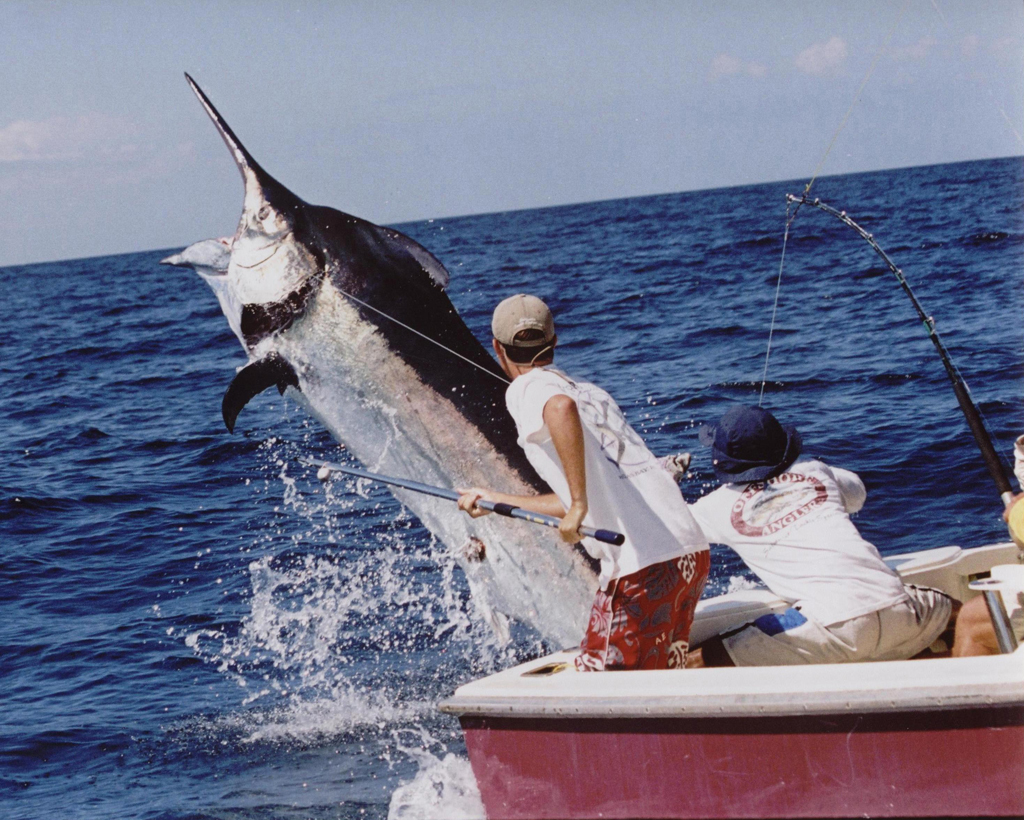Black Marlin
ISTIOPHORIDAE FAMILY; also called white marlin (Japan), silver marlin (Hawaii)
As the names suggest: the Black marlin isn’t exactly black in color! In fact, it often looks much more blue than a Blue marlin.

You're going to see
this image a lot in Cabo: many of the hawkers around the marina use it to
advertise their fishing trips. The problem is that, although it is a Black
marlin, it has never been near Cabo! It was actually caught in Panama at Tropic
Star. Our CEO has fished on that boat and knows the crew - he thinks the
photo was taken by Guy Harvey, the artist!
The Black marlin occurs in the tropical Indian and Pacific oceans. In tropical areas distribution is scattered but continuous in open waters; but they are denser in coastal areas and near islands. A few stray Black marlin travel around the Cape of Good Hope into the Atlantic. Some have been known to cross the ocean from there, traveling in a southwesterly direction as far as Rio de Janeiro, Brazil, or in a northwesterly direction as far as the Atlantic coasts of the Lesser Antilles. Such excursions are, however, regarded as exceptional. Little is known of the migrations of this pelagic species, but they do not appear to be extensive except in unusual cases.
They are not numerous around Los Cabos but they are caught every year in the summer and early fall months, usually by "accident" when trolling. Blacks tend to hang around reefs and structure with large concentrations of bait so the underwater mounts off the tip of the Baja peninsula like Gordo Bank and Jaime Bank are prime places where, if you wanted to specialize on them only, you can bridle a live skipjack or yellowfin tuna and slowly bump the boat in and out of gear until a marlin spots it and decides to eat.
A Black marlin can be quickly and positively identified since it is the only marlin that has rigid pectoral fins that cannot be folded flat up against the body without breaking the joints. It is also set apart by the airfoil shape of the pectoral fins and by its very short ventral fins, which almost never exceed 12 in (30 cm) in length, regardless of the size of the fish. The first dorsal fin is proportionately the lowest of any billfish, usually less than 50% of the body depth. The body is laterally compressed, rather than rounded; much more so than in similar sized Blue marlin.
The body is slate blue dorsally, changing abruptly to silvery white below the lateral line. When feeding or leaping, the Black marlin may display light blue vertical stripes on the sides. Slight variations in color cause some specimens to have a silvery haze over the body.
A highly rated game fish, the Black marlin has the power, size, and persistence of which anglers dream. Its diet consists of squid and pelagic fishes. Fishing methods include trolling with large, whole baits (mackerel, bonito, flying fish, squid and others) or with artificial lures. Live bait is also effective.
Though there are some exceptions, giant Black marlin are larger than giant Blue marlin taken on rod and reel. This may be because large Black marlin are more accessible and more often occur within the range of sportfishing vessels.
Black marlin, or any marlin, larger than 300 lb (136 kg) are almost always females.
Current Black Marlin All Tackle Record
1560 lbs. 0 ounces
Best time to catch a Black marlin in Cabo : From July until early November.